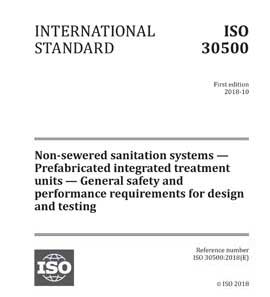Since its formation in 1926, IAPMO has been known for its progressive focus on the future. One might believe sanitation and the use of resources have reached a peak; this sort of thinking, however, is not within the realm of IAPMO’s culture. IAPMO Codes and Standards excels in recognizing technology that improve the lives of Americans and elsewhere. Over time, IAPMO has proven to be the leader in bringing innovation to the industry while, at the same time, protecting the public health and welfare.
Non-Sewered Sanitation Systems
Since the early 1900s, technologies from flight to telephones have advanced with tremendous progress. We have gone from a simple 12 horsepower engine propelling an aircraft to jets that can break the sound barrier. Telephones have gone from rotary dial and cords to smart phones that have far more computing power than all the computers used to send the first man to the moon in 1969.
But what about wastewater management? It has not really advanced much. Yes, the sanitation is far safer than it was in the early 1900s, but the concept is the same. Not to mentioned that more than 2.3 billion people across the world lack access to basic sanitation services.
Now there is technology that is attempting to take sanitation to another level. It is technology that has already benefited areas where resources are scarce. Any country that adopts this technology has taken a leap into the future of sanitation. This technology is the Non-Sewered Sanitation System (NSSS) and it is covered by the ISO 30500 standard.
ISO 30500, Non-sewered sanitation systems – Prefabricated integrated treatment units – General safety and performance requirements for design and testing, seeks to provide general safety and performance requirements for the product design and performance testing of these non-sewered sanitation systems. It applies to integrated sanitation systems that are not attached to a sewer.
The ISO 30500 Standard Helps Develop New Toilet Technology That Will Save Millions of Lives
Imagine using a toilet where the drainage system has the capability of preserving energy for use in other applications, such as powering lights, and with a recirculation loop for fluid reuse. Imagine a remote location where there is no water supply or a drainage system, yet you can have a fully functional toilet or urinal. The possibilities are endless with the use of the NSSS technology.
IAPMO is leading this effort to bring the NSSS technology to countries such as the United States and Canada. A committee with both U.S and Canadian stakeholders is preparing to bring the ISO 30500 standard to these respective countries as an American National Standard (ANS) and National Standard of Canada (NSC).
States like Hawaii or other areas where the use of cesspools is of concern, or California where droughts are common, can benefit from this technology. Likewise, provinces in Canada can also derive benefit.
Safe sanitation is something that IAPMO takes seriously and IAPMO feels privileged to be selected as the Accredited Standards Developer (ASD) by ANSI to introduce this technology to the U.S. and Canada.
Leak-Detection Systems
As stated, there are areas where resources are scarce. Such scarcity does not only apply to underdeveloped nations but well-established, developed nations, as well. There are areas in the United States where safe and sanitary water is not a basic commodity. From California to New York, and around the globe, water is a resource that must be cherished and protected. A drop of water the size of grain of rice can be easily ignored or overlooked due to its local minimal effect. This miniscule drop multiplied numerous times of water. This now becomes something that cannot be overlooked.
IAPMO Codes and Standards is once again at the forefront tackling this issue. IAPMO has long published standards that address water-leaking detection products. Those standards are the IAPMO IGC 115 and IAPMO IGC 349, which are expected to become national standards soon (IAPMO Z1115 and Z1349). These standards are being used for the listing and certification of products designed to detect water leaks. Jurisdictions nationwide are already looking for the IGC 115 and IGC 349 mark for these products.
The water-leak-detection technology listed to the IAPMO standards has the capability of letting the homeowner know if there is a water leak with the use of a smartphone. Aside from preserving resources, a homeowner will save money on their water bill and insurance companies can have peace of mind that water leaks will be detected prior to causing major damage to the structure. Aside from damage to the structure, leaks that are not properly fixed can cause mold to grow.
IAPMO Codes and Standards prides itself as being the go-to-source for new and novel products. There are many plumbing technologies that began as an IAPMO standard and slowly became a normal part of our lives. Many innovators and manufactures have taken advantage of IAPMO’s services to ensure that their novel products find their way into the industry. As technology rapidly improves, IAPMO Codes and Standards is ready to meet the needs of the industry.
Code Development
The IAPMO codes provide consumers with safe and sanitary systems while, at the same time, allowing latitude for innovation and new technologies. The industry looks to IAPMO codes to address innovations or novel products.
The Uniform Plumbing Code (UPC) introduced an appendix that provides a modern way of sizing water supply piping. The newly developed Water Demand Calculator (WDC) recognizes that the world is now utilizing lower flowrate fixtures. In many states, it is law to use low-flow fixtures. Due to the lower water demand, the existing water pipe sizing method used will typically lead to oversizing, which means more volume of water in the piping. The larger volume of water equates to longer waits for the hot water to come out of the shower. This also leads to more water waste. The UPC is the only code that takes all this into account with the Water Demand Calculator (WDC) in Appendix M. The WDC is the first update since Hunter’s 1940 Curves to estimate peak water demand for single and multi-family dwellings using efficient fixtures. It reduces meter and pipe sizes and increases cost savings.
The Uniform Mechanical Code (UMC) was the first national mechanical code to address A2L refrigerants. A major milestone that introduced lower flammability refrigerants such as A2L and B2L. The industry’s concerns to address lower Global Warming Potential (GWP) refrigerants led to the development of these lower flammability refrigerants.
But why stop there? The Uniform Codes also have up-to-date provisions for geothermal, solar thermal energy systems and hydronic energy systems.
IAPMO’s codes based on principle and on a proven consensus process, the ANSI process. It is the only process that has been proven time and time again to employ true consensus. It is a development process that is used internationally for a reason. It is a process that has an oversight from a third-party to assure true consensus.
Whether it is codes or standards, IAPMO is the Standards Development Organization that is bringing innovation to the industry. Jurisdictions everywhere are taking advantage of IAPMO’s proven process because IAPMO codes and standards are developed by the industry for the industry. The Uniform Codes don’t only claim to be ahead of the curve, they are.
Please visit us at https://www.iapmo.org/standards-development/american-national-standards for more information.

Hugo Aguilar, P.E.
Last modified: December 29, 2022

